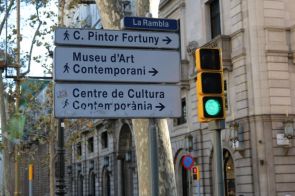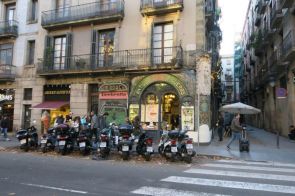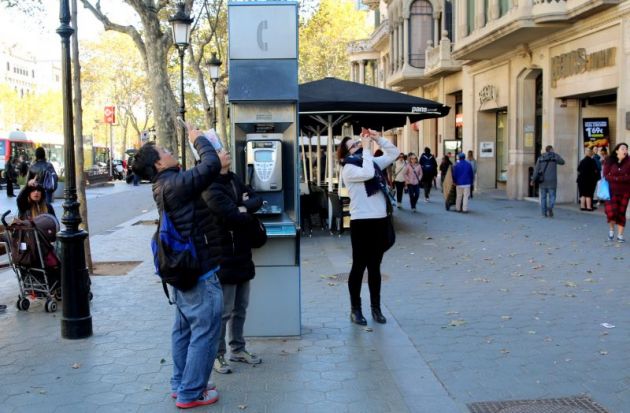During a cool season visit to Paris, why not detour to sunny, spectacular Barcelona?

For many travelers the period from fall to winter is a good time to visit France and Spain or Barcelona.
The summer crowds have thinned; it's easier to get transport and hotel bookings, and the peak-period prices are down.
In the City of Light, the temperature can get a bit chilly at this time of the year. When it hovers around 40 degrees F (5 degrees C) in Paris it might be an idea to pop down to Barcelona in the Catalan principality of northeastern Spain.
The area is famous for its iconic and individualistic architecture and art. Of course if you want some cold and skiing the Pyrenees Mountains are close by.
In Barcelona the temperature is likely to be closer of 65 deg. F (18 deg. C) and the sun shining.
On the very fast train (TGV) it is a glorious ride along the south western part of France along the area of Spain bordering the Costa Brava to Barcelona.
Spain's railway company Renfe and France's SNCF run a TGV service, running at speeds in excess of 200 miles per hour (320 kilometers per hour) that connects 21 international destinations.
FAST LINKS TO BARCELONA
"These days there are direct connections linking Barcelona and Paris in 6 hours 15 minutes, Madrid and Marseille in 7 hours 40 minutes, Barcelona and Lyon in 5 hours...so it is easy to come down here," says Claudia Fresquet, a press officer for Renfe.
The link between Barcelona and Toulouse in 3 hours and once in the Catalan capital there is a glorious array of architecture and museums that shows of the city's variety of turret and balconies.

Since Barcelona hosted its very successful Summer Olympics in 1992, it has transformed into one of the world's most popular touristic cities. Catalonia is quite autonomous from the rest of Spain and it is the most powerful economic hub as well as a wine-producing region.
One of Barcelona's most emblematic landmarks is La Sagrada Familia (Holy Family church), the large Roman Catholic church with its spiky towers, designed by Catalan architect Antoni Gaudí that is a UNESCO World Heritage Site.
If you are pressed for time even in a few days you can cram in inspiring cultural tours with or watch a match at FC Barcelona, which some would argue is the world's top soccer club.
Another striking architectural building is the Casa de les Punxes. It is at the junction of Diagonal Avenue in the heart of Barcelona's "Quadrat d'Or" (Golden Square).
This is a majestic masterpiece from Josep Puig i Cadafalch, considered one of the most influential Catalan art nouveau architects, who passionately interwove his loves architecture, politics and historical scholarship.
Casa de les Punxes is a majestic, medieval-inspired, but modernist urban palace that has a stunning view of Sagrada Familia, the church of the Holy Family that is sometimes seen as a symbol for the Catalan city.

The top of the building has a panoramic view of the Barcelona skyline and the historical tales of the legends of Catalonia regale inside its walls.
"This beautiful building with its spiky towers brims with exquisite multimedia expositions of St. Jordi (George) the patron of Catalonia," who is also venerated in England and other countries, says Montse Jimenez, marketing director at Casa de les Punxes.
Taking a stroll toward La Rambla, Barcelona's famed tree-lined pedestrian mall you are drawn to crowds standing outside Casa Batlló with eyes cast upward to Antoni Gaudí's building masterpiece that pulls in passersby.
This seductive house with it curvaceous balconies is considered a modern artistic treat to mythical magic.
Go behind the amazing modernist façade which mirrors a calm sea hiding layers surprises and refined architectural minutiae.

There is always time for lunch in Barcelona and at Monvinic on Diputació 249 near the Coliseum Theater you can have a delectable wine bar set menu at 19,50 euros with a wide choice of wines.
While La Rambla and the Ciutat Vella (Old Town) can feel like a tourist circus in high summer in the cooler part of the years the throngs are thinner and easier movement around markets like that at St. Josep La Boqueriua.
Dating back to 1217 the public market proliferates with food and after lots of walking you dive into some of its nooks that serve energy boosting tastiest washed down with wine, beer and other beverages.
Renfe/SNCF sponsored Peter Kenny's visit to Bareclona
